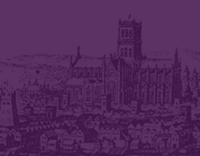The High Middle Ages was a period governed by hierarchies. Living in times of political instability, violent epidemics, and wars at home and abroad, medieval men and women sought certainty and order. Through hierarchies, medieval scholars were able to organize the “known world” into a comprehensible system where everyone or everything had its place. The most familiar of these hierarchies is known as the Great Chain of Being.
In passages like Psalm 8, medieval readers found a divinely ordered universe:
O Lord, our Lord,
how majestic is your name in all the earth! . . .
When I consider your heavens,
the work of your fingers,
the moon and the stars,
which you have set in place,
what is man that you are mindful of him,
the son of man that you care for him?
You made him a little lower than the heavenly beings
and crowned him with glory and honor.
You made him ruler over the works of your hands;
you put everything under his feet:
all flocks and herds,
and the beasts of the field,
the birds of the air,
and the fish of the sea,
all that swim the paths of the seas.
O Lord, our Lord, how majestic is your name in all the earth! (NIV)
This view of our “Middle Station,” placed “a little lower than the heavenly beings” and above the rest of creation suggested to the medieval mind a world with a place for everything and everything in its place. They took the Psalmist’s bare outline with similar systems found in Aristotle and elaborated them into a Great Chain of all life, connecting the earth firmly to the heavens. Each rank or level was represented by a link of that chain beginning with the Vegetable and then the Animal world and rising from the human orders to the Angels until you reached God.
 Great Chain of Being
Great Chain of Being

The desire for order systematized such a hierarchy further by distinguishing between noble animals like the eagle and brute beasts such as the ox. Some, like Pope Gregory I, went further to see hierarchy in heaven itself: “We know on the authority of Scripture that there are nine orders of angels, viz., Angels, Archangels, Virtues, Powers, Principalities, Dominions, Throne, Cherubim, and Seraphim.” Therefore, hierarchies appeared to be a part of God’s nature, and since they were founded upon the authority of scripture and classical learning they were seen–like the metaphoric chain itself–to be fixed and immutable.
Another familiar hierarchy divided medieval society into Three Estates. This social hierarchy also illustrates certain tensions already apparent in the Middle Ages. For an overview of the basic degrees, read the “Medieval Estates and Orders” article at Norton Topics Online. Since Chaucer uses the estates to order his “General Prologue,” you will want to be familiar with this framework.
 Medieval Estates and Orders
Medieval Estates and Orders
In Chaucer’s “General Prologue,” we start to sense problems or tensions inherent in social models like the medieval estates. Has God placed secular authority (Kings, Princes, and Nobles) above or below sacred authority (Popes, Archbishops, and Bishops)? Are these positions truly fixed, or can they allow for movement between stations? Where do merchants who neither fight nor labor fit into the system? As we’ll see, by the end of the Middle Ages, familiar hierarchies and symbols of order began to give way to new ways of seeing the world.
For an interesting glimpse of this tension, watch the opening 10 minutes of “The Monk,” one of a series of Monty-Pythonesque documentaries put together by ex-Python Terry Jones. In this episode of the BBC’s Medieval Lives, he describes some of the early excesses in the medieval church as well as early reforms by monks like St. Benedict.
 Terry Jones’ “The Monk”
Terry Jones’ “The Monk”
 The Middle Ages has often been seen as a transitional period between the golden age of ancient Rome and the rebirth, or renaissance, of learning and the arts in Europe in the 15th or 16th century. However, as we encounter smart, witty writers from Chaucer to Margery Kempe, you’ll begin to understand what a lively period the “The Dark Ages” really was.
The Middle Ages has often been seen as a transitional period between the golden age of ancient Rome and the rebirth, or renaissance, of learning and the arts in Europe in the 15th or 16th century. However, as we encounter smart, witty writers from Chaucer to Margery Kempe, you’ll begin to understand what a lively period the “The Dark Ages” really was.









